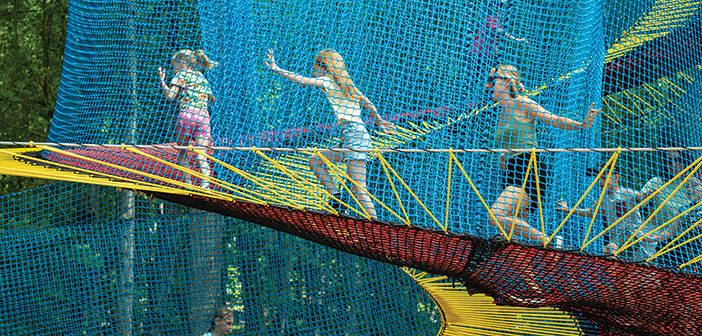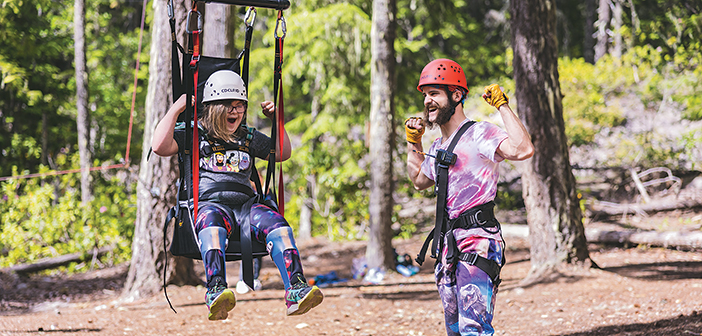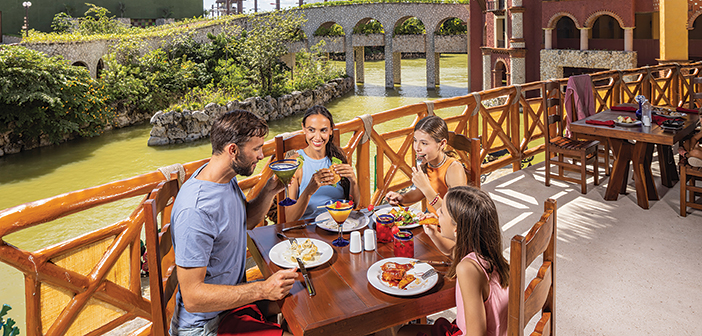What’s an adventure experience without a good debrief? Since its inception, API has profiled a wide variety of adventure operations within its pages as part of the ongoing Park 360 series. The passion, dedication, and enthusiasm for the aerial adventure industry shines brightly within the profiles, which examine parks far and wide with varied offerings and program delivery. What follows here is a debrief of the common themes and wisdom found throughout some of those more recent profiles.
EXPAND YOUR AUDIENCE
Too often, operators overlook key consumer groups when creating programming and offerings. For example, a large percentage of us in the aerial adventure industry connect with the adventure- and adrenaline-seekers participating in our activities. But we sometimes neglect those individuals who may not share that same level of experience or penchant for risk.
This tendency can lead to construction of a park that is, as Go Ape CEO Vernon West put it, in “Go Ape Goes West” (Fall, 2021), “half built,” with gaps that exclude guests who are nervous, young, or have limited abilities. There are different ways to fill those gaps, but the more people that can play at your operation—more, as in, different ages, abilities, interests, etc.; not necessarily more volume of people—the more fun that can be had, and the better your business will be.
So, take the time to look at your offerings and ask the question: Who are we leaving out?
Family-friendly. Offering programs, elements, and activities that are unique and accessible to a wide variety of participants and guests is a way to increase demand. Consider Upla (“The Hoopla for Upla,” Fall, 2022), an adventure park located in the suburbs of Montreal, which has found early success with a low-skill, family-friendly attraction—a multi-level, brightly-colored network of netted trampolines, tunnels, slides, and ramps. The netted network creates multifunctional spaces that allow for a self-guided, personalized experience for a wide variety of individuals. The attraction’s striking visual impact and the open-ended invitation to bounce around encourage adults and kids alike to jump in and play.

Upla is the playful, catchy brand name for a new netted attraction in Quebec.
Accessibility. The gaps in access to aerial adventures are especially large for folks who have disabilities. “Adapting for Your Audience” (Winter, 2023), looks at Mt. Hood Kiwanis Camp in northwest Oregon, which began focusing on serving those with developmental and intellectual disabilities in the 1950s. The camp’s mission to empower those with disabilities through equitable access to the outdoors and recreation has led to opportunities for these oft-excluded participants to experience personal growth and, of course, have fun.

Mt. Hood Kiwanis Camp serves children and adults with disabilities, an audience that is often excluded from aerial adventure activities.
As MHKC executive director Dave McDonald explained, the activities attendees take part in at camp are “the experience of a lifetime” for most campers.
While not achievable for some sites, accessibility is worth the time and effort to address in operations. The impact of equitable access to adventure activities on individuals, families, friends, etc., is truly life changing. Not to mention that, according to the Center for Disease Control and Prevention, roughly one in four American adults live with a disability (mobility, cognition, hearing, vision, etc.)—a huge potential market.
Expanding our audience in responsible and appropriate ways will only help us grow as an industry; it should be a priority for any operation looking to have a real impact in the adventure world.
LET GUESTS DRIVE BUSINESS DECISIONS
When your guests tell you what they want, listen. Guests will often provide feedback, ask about specific goods, request services, or inquire about other activities. Generally, these questions start with “do you have…?” This information can tell you a lot about what people want and how they are willing to spend their hard-earned money. Track common requests and look for ways to address them.
Ancillary products. Go Ape managed to quadruple its ancillary earnings by simply observing customers’ wants and needs. “We’re serving more previously unmet needs in terms of providing products that people find valuable as part of their experience,” said West. New merchandise options such as branded cups, buffs, and a wider range of gloves resulted in higher sales and can improve customer satisfaction.
Adding ancillary products and offerings such as merchandise and F&B can also be a way to round out your offerings, disperse guests, and keep people in your park longer. Consider Xcaret in Cancun, Mexico (“The Cancun Colossus,” Summer, 2022). Xcaret’s adventure parks are unusual in that they are all-inclusive, which means food and non-alcoholic beverages are part of the package. Nonetheless, having food and beverage outlets helps create other revenue-generating opportunities, such as alcohol, souvenir, or other incidental purchases.

Xcaret’s all-inclusive food and beverage encourages guests to stay longer and spend more on incidentals.
Also, having multiple waystations in one park allows Xcaret to spread out the crowds and keep guests entertained between activities. Happier guests who have access to what they want hang out longer, resulting in better performing operations.
NURTURE YOUR GUESTS WITH NATURE
During the pandemic, many people flocked to outdoor natural spaces to find solace and safety. As Go Ape’s West noted, “People are reconnecting with nature. They’ve probably connected to nature in a way they haven’t done for years, and I think that will awaken something.” That awakening points to an opportunity to include environmental education as a part of adventure offerings, in commercial and more traditional settings alike.
Even before the pandemic saw outdoor participation boom, Brian Funtleyder, co-owner of park building and management company Boundless Adventures, worked with Pringle Nature Center in Bristol, Wis., to develop a network of aerial adventure courses to supplement educational activities already in place at the center (“An Educational Opportunity,” Winter, 2019). Why?

Activities at Pringle Nature Center focus on providing a way for people to connect with the natural world.
The simple answer: because the forest is right there. “Some parks have completely ignored the fact that they’re in the woods,” said Funtleyder.
Not including an environmental education component is an opportunity lost. “The benefits [of an environmental education component]far outweigh the costs,” he argued. Guests appreciate the opportunity to bring more home than just a souvenir t-shirt; a long-lasting connection to the natural world, and newfound knowledge of it, can be deeply gratifying. Operators can foster such connections and should take advantage of the resources already at their disposal.
CLIMB Works Keana Farms in Oahu, Hawaii, is another example of this (“Hawaii State of Mind,” p. 46). The zip tour operates on a working farm that produces more than a million pounds of produce a year on Oahu’s famous North Shore. As part of the zip tour experience, guests eat fresh farm offerings like cherry tomatoes, bananas, and macadamia nuts, learn about the farm’s operation, and explore Hawaiian culture and history through informational plaques and guide-led education.
The programming is impactful: “People might come out looking for an adrenaline rush, but they leave with a better understanding of and respect for Hawaii and its rich history,” said CLIMB Works owner Nick Thompson.
MAKE IT EASY AND RECOGNIZABLE
We’ve all been there: You’re interested in purchasing something online but aren’t 100 percent sold. You reconsider, and never complete the transaction.
Conversion. Those incomplete transactions are reflected in an operator’s conversion rates (the percentage of the total number of visits to a website that result in a purchase). When West found Go Ape’s conversion rates were below the desired percentage, his team investigated the cause. They discovered that a recent software change had led to a “high-friction e-commerce customer booking experience.” It had become harder for guests to book an experience.
To fix it, the team moved the most important items “above the fold” on the website, were intentional in their use of colors and graphics, and reduced the booking process by a step, leading to fewer dropouts from the process. Put simply: Making the booking process quick and easy means guests are more likely to actually go through with it.
Branding and name recognition are also important factors when it comes to conversion. The Trekking Group CMO Jean-François Couture invented the word “Upla” for the Quebec-based park to strengthen its brand value.
“I invented the word while seeking a playful, meaningful, simple, and catchy brand name,” he explained. The Upla trademark joins The Trekking Group’s other Quebec-based properties under the umbrella brand name Arbraska, another invented moniker of Couture’s.
Made-up words, called “arbitrary marks,” have the highest brand value due to their strong trademark protections and evocative nature. The lesson: If you want guests to remember you, create innovative, easy to remember, and fun branding to stand out from the crowd.
COMMUNITY IS KEY
While business may be the bottom line, community relationships are also a cornerstone of long-term success. Investments that benefit the environmental, cultural, and economic stability of communities hit the trifecta in terms of responsible and impactful practices.
Zip World of North Wales, and The Wilds of southeast Ohio, are two operations that have made the reclamation of used and abused mining lands central to their mission (“Mining for Adventure,” Summer, 2020). Projects involving land restoration, a focus on locally sourced materials, and employment opportunities for otherwise deprived communities have created a web of support from the surrounding populations.

The reclamation of old mining lands in North Wales was key to Zip World’s vision.
The Wilds vice president Dr. Jan Ramer said building a park on reclaimed coal-mined land was a costly endeavor, but the positive economic impact has been tremendous for neighboring communities. The Wilds contributes nearly $15 million to the regional economy, according to a study conducted by Ohio State University.
Zip World, built on old mining grounds in North Wales, has had an even greater impact on its surrounding communities and economy, bringing in $325 million over a five-year period.
“Our towns and villages are quite deprived post-agricultural and industrial communities,” said Sean Taylor, founder and CEO of Zip World. “We employ 450 staff at the busiest time. We have a headquarters in Llanrwst. Our supply chain—fences, equipment, harnesses, and trolleys—consists mostly of goods that are all made locally. It’s fairly rewarding to be in a position to do that.”
Not only is it rewarding to run a business with a positive impact, guests also appreciate the opportunity to be champions for a cause. A global survey by management consultancy firm Accenture found that 60 percent of consumers were making more environmentally friendly, sustainable, and ethical purchases.
Lessons to be learned. In short, there’s a lot to be learned from the Park 360 profiles, even when the profile might be quite different from your own operation. The profiles illustrate how other operators have defined and fulfilled their mission, and can spark ideas that help you refine or expand your own goals. Innovation is hard; let your peers provide a starting point.





